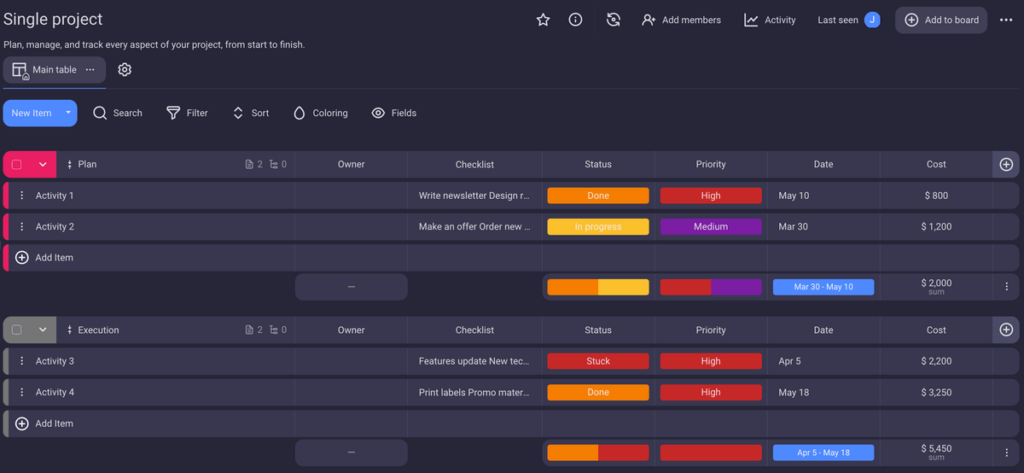Project managers use estimate at completion (EAC) as a method of estimating total project costs while the project is ongoing. EAC helps them spot deviations from the initial assessments and adjust the budget accordingly when necessary.
EAC is a great tool in project management, and it can be calculated in various ways, based on the current project circumstances.
Find out what to do when you have a project with varying costs on your hands and how to forecast the necessary budget on time.

- EAC is used for project cost forecasting and calculated when the project is already in progress.
- There are 4 different ways to calculate EAC, depending on the current project circumstances.
- A major benefit of using EAC in project management is that it helps pinpoint cost and schedule deviances early on.
What is the estimate at completion (EAC) in project management?
Estimate at completion (EAC) is a forecasting technique project managers use to determine the project cost at its completion while the project is in progress.
Sometimes, projects don’t progress as planned, and the actual costs are higher than anticipated.
This technique considers variables such as unexpected costs and inaccurate early estimates in its calculation.
As the project progresses, it’s important to develop accurate cost forecasts of the remaining workload and estimate the final project cost.
How to calculate EAC
There are 4 ways to calculate EAC in project management, depending on the circumstances of the project.
| Formula | When to use |
|---|---|
| EAC = AC + ETC | The initial forecast is no longer viable. |
| EAC = BAC / CPI | The project is performing as planned. |
| EAC = AC + (BAC – EV) | The project is expected to meet the estimated budget. |
| EAC = AC + (BAC – EV) / (CPI × SPI) | Both cost and schedule affect the project budget. |
Let’s explore all 4 formulas and see which data you need to use for each.
EAC formula #1
This formula is ideal when you need to change your plans entirely because:
- Your current project performance differs significantly from the planned performance, and
- The initial estimates are flawed and no longer applicable.
Here’s this variation of the EAC formula:
EAC = AC + bottom-up ETC
The actual cost (AC) is the sum of the real costs incurred up to a certain point of project development.
Meanwhile, the estimate to complete (ETC) forecasts the necessary funds to complete the remaining project work. Using a bottom-up method means every member of the project team has to estimate the cost of their remaining work.
The main difference between ETC and EAC is the range of costs they cover. ETC sums up only the costs of the remaining project work while EAC estimates the total costs of the project from start to finish.
Let’s illustrate this formula with an example.
Suppose your project budget is $150,000. Your team has completed 40% of the project work against 50% of the planned work and has spent $85,000 by now.
| Measure | Value |
|---|---|
| Budget at completion (BAC) | $150,000 |
| Earned value (EV) | 40% |
| Planned value (PV) | 50% |
| Actual cost (AC) | $85,000 |
The project costs are high for the amount of work performed, so you need to determine the cost for each remaining project activity and add ETC to the actual costs.
After discussing the remaining work with the team and project stakeholders, you conclude that the sum of the remaining costs (ETC) is $112,000.
Now, you can use this value to calculate EAC.
EAC = AC + Bottom-up ETC
EAC = $85,000 + $112,000
EAC = $197,000
This means that instead of the planned $150,000, you’ll need $197,000 to complete your project under new circumstances.
EAC formula #2
If the performance is going as planned, use the following formula to calculate EAC:
EAC = BAC / CPI
The budget at completion (BAC) is the sum of all budgets allocated to the project work. It’s the total planned value of the project, determined at the beginning of the project and based on the project work.
The difference between BAC and EAC is that the former sums the budget for the entire project before it begins, while the latter estimates the project’s final cost when the project is already underway. If EAC is higher than BAC, your project exceeds the planned costs, and vice versa.
The cost performance index (CPI) measures the project’s cost efficiency by dividing earned value by actual cost. The result shows how the project is performing:
- CPI < 1 — the project is over budget.
- CPI = 1 — the project is performing on budget.
- CPI > 1 — the project is under budget.
Let’s see another example.
Say your project budget is $85,000. Your team has completed 45% of the project against the 55% of planned work and has spent $40,000 by now. You assume CPI will remain the same until the end of the project.
| Measure | Value |
|---|---|
| Budget at completion (BAC) | $85,000 |
| Earned value (EV) | 45% |
| Planned value (PV) | 55% |
| Actual cost (AC) | $40,000 |
First, let’s calculate the cost performance index:
CPI = EV / AC
CPI = (45 x $85,000 / 100) / $40,000
CPI = $38,250 / $40,000
CPI = 0.95625
Since the CPI is below 1, we can conclude that the project is performing over the budget.
So, let’s calculate the new budget.
EAC = BAC / CPI
EAC = $85,000 / 0.95625
EAC = $88,888
This means you will need $88,888 instead of the planned $85,000 to complete your project under new circumstances.
💡 Plaky Pro Tip
To make sure project funds last, project accountants can use EAC, BAC, and many other metrics to track expenditures. To learn more about project accounting in general, read this guide:
EAC formula #3
This formula is appropriate when the project manager believes the project will perform according to the budgeted rate moving forward, regardless of its prior performance.
EAC = AC + (BAC – EV)
Earned value (EV) measures the project’s progress and performance by multiplying the percentage of completed work by the budget at completion. When the project is performing well, earned value equals the planned value.
To illustrate, suppose your project budget is $100,000. Your team has completed 50% of the project work against 40% of the planned work and has spent $50,000 by now. You also believe your project team will accomplish the remaining work at the budgeted rate.
| Measure | Value |
|---|---|
| Budget at completion (BAC) | $100,000 |
| Earned value (EV) | 50% |
| Planned value (PV) | 40% |
| Actual cost (AC) | $50,000 |
First, you need to find out the project’s earned value:
EV = % of work completed x BAC
EV = 50% x $100,000
EV = $50.000
Now, you can calculate the estimate at completion (EAC).
EAC = AC + (BAC – EV)
EAC = $50,000 + ($100,000 – $50.000)
EAC = BAC = $100,000
In this case, you can expect the project to be completed within the planned budget, as the estimate at completion is the same as the budget at completion.
EAC formula #4
The fourth way you can calculate EAC is appropriate for situations where both the cost and the schedule influence the remaining project work.
EAC = AC + (BAC – EV) / (CPI × SPI)
The schedule performance index (SPI) shows whether the project is straying from its planned schedule. Based on its value, we can tell the following:
- SPI > 1 — the project is ahead of schedule.
- SPI < 1 — the project is behind schedule.
- SPI = 1 — the project is on schedule.
For example, suppose your project budget is $250,000. Your team has completed 25% of the project against the 35% of the planned work and has spent $75,000 by now. In addition, both CPI and SPI influence the remaining workload.
| Measure | Value |
|---|---|
| Budget at completion (BAC) | $250,000 |
| Earned value (EV) | 25% |
| Planned value (PV) | 35% |
| Actual cost (AC) | $75,000 |
First, you need to figure out the earned value:
EV = % of completed work x BAC
EV = 25% x 250,000
EV = $62,500
Then, you should determine the planned value:
PV = % of project completed (planned) x BAC
PV = 35% x 250,000
PV = $87,500
Afterward, you have to figure out the cost performance index (CPI):
CPI = EV / AC
CPI = 62,500 / 75,000
CPI = 0.83
Finally, you should calculate the schedule performance index (SPI).
SPI = EV / PV
SPI = 62,500 / 87,500
SPI = 0.71
The SPI value tells us the project is behind schedule.
Now that you have all the necessary values, you can go ahead and calculate the EAC.
EAC = AC + (BAC – EV) / (CPI × SPI)
EAC = 75,000 + (250,000– 62.500) / (0.83 × 0.71)
EAC = $393,174.10
As you can see, you will need $393,174.10 to finish your project, which is significantly higher than your BAC of $250,000. The project is therefore both behind schedule and over budget.
📖 If you found this guide helpful, head on over to our Project Management Glossary of Terms to learn about the other elements of earned value management, or browse the list for more project management topics that might interest you.
Benefits of applying EAC
The benefits of using EAC as a forecasting tool are mostly tied to your ability to detect budget issues early on and fix them on time.
Here’s an overview of the positive sides of using EAC in project management:
- Early issue detection — When the project manager notices a deviation from the planned values, they can take immediate action. That way, it’s easier to prevent larger issues that can affect the project’s delivery on time and within budget.
- Tight budget and schedule control — If management tracks all the parameters we described, they’ll identify where cost overruns happen and know exactly what to focus on.
- Transparency — Projects rarely go according to plan, but finding out what will cost more and which project activities may take more time lets project managers communicate more openly with project stakeholders.
Track your project’s performance with Plaky
If you want to keep all project cost information in one place, we recommend trying a project management app like Plaky.
With Plaky, you’ll get a more intuitive and user-friendly alternative to spreadsheets that allows you to:
- Jumpstart your projects fast using a variety of useful project management templates,
- Organize your project tasks with customizable fields,
- Distribute and assign tasks within your project team,
- Add tags to items to specify responsible departments,
- Track expenses in several currencies, and
- Collaborate and communicate with team members through comments.

Managing projects is so much easier when you can involve the whole team and easily share information. And with Plaky, you get a centralized hub for all your activities and efficient progress tracking.
Enjoy effortless project management with Plaky. Create an account today and try all Plaky features for free.
How we reviewed this post: Our writers & editors monitor the posts and update them when new information becomes available, to keep them fresh and relevant.

